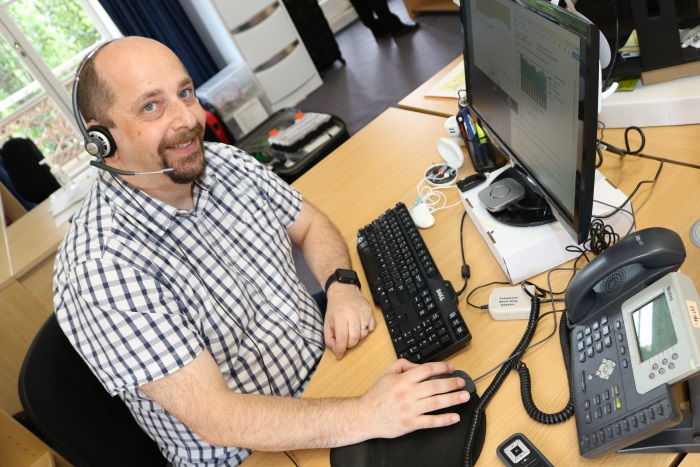Employment Assistance Fund

Photo: Daniel Pistritto at his workstation with assistive hearing devices funded by the Employment Assistance Fund (Source: Blamey Saunders hears)
A perfect pitch solution for Daniel
Daniel Pistritto, an Audiometrist and Assistive Listening Device Product Manager at Blamey Saunders hears, believes it is essential “to protect ears from loud noises when one is younger so that the loss of hearing does not impact the quality of life in their later years.”
Daniel was diagnosed with progressive hearing impairment in his early teens. With a professional background in information technology, Daniel spent many years in the field and enjoyed doing his work. Over time, however, he realised the effect gradual hearing loss had on his ability to continue in the same industry and decided to switch careers to audiometry.
“I wanted to understand my hearing problem better as well as help others in the same situation. It was this passion that drew me to undertake a course in audiometry, and join my current employer,” Daniel said. In his role as an audiometrist, Daniel meets clients with hearing issues, tests their hearing, and fits them with hearing aids. While the career change was a rewarding experience, Daniel’s hearing condition impacted his work.
“The biggest challenge was to understand what was happening in the office. For instance, participating in large meetings with 20 to 30 people was difficult when conversations moved quickly from one to the other. I would position myself close to the presenter and yet miss out on important parts of the discussion. As a result, I was too nervous to contribute to meetings, and the easiest thing was not to say anything.”
“Another challenge was to gauge clients’ hearing levels during our speech perception test,” Daniel shares. “The test requires the client to listen and respond to single syllable words to assess their hearing. I wasn’t able to sufficiently understand the client’s response, which made it difficult to provide recommendations.”
The need to overcome challenging situations such as these saw Daniel get in touch with JobAccess and lodge an online application for the Employment Assistance Fund to secure funding support for assistive hearing devices.
A few days later JobAccess organised an occupational therapist to visit Daniel’s workplace to learn about his role and conduct a site assessment. “Having someone come out to the workplace and understand more about me and the challenges I was facing made a big difference. The therapist went above and beyond in her recommendations of possible solutions.”
Shortly after the assessment, JobAccess approved Daniel’s request for a Mini Mic 2 and Roger Receiver, along with funding for other additional devices suggested by the therapist. “I was a bit nervous as I was asked to pay for the devices initially, but the Employment Assistance Fund (EAF) reimbursed the costs within two days, and delivered on what they said. Plus, the modifications funded through the EAF have been fantastic! The tools and devices help me hear and understand people over the telephone, in meetings as well as other noisy situations at work.”
With simple workplace modifications, Daniel has been able to engage with his clients and colleagues better as well as take on broader responsibilities. In addition to meeting clients in person, Daniel now provides consultation via telephone and video conferencing to clients across the country who require support with their hearing or adjustment of their hearing aids. “Something I believe in and always share with my clients is that ‘there is most definitely light at the end of the tunnel’.”
Did you know?
- Hearing loss is one of the most common conditions affecting Australians. A 2017 report [PDF 1.9 MB] by the Hearing Care Industry Association and Deloitte Access Economics found that hearing loss (in the better ear) was prevalent among 3.6 million people, or 14.5% of the Australian population in 2017. Moreover, the financial cost due to reduced employment of people with hearing loss estimated at $9.3 billion.
- The World Health Organisation reports that 60% of childhood hearing loss and 37% of hearing loss in adults is due to preventable causes, which can be addressed through early identification, treatment and modifications using hearing aids and assistive devices.
Last updated:
